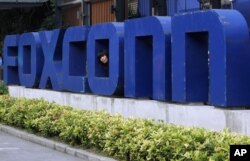A boom in production of Apple iPhones is helping lift the economy of Taiwan, an industrial center that still relies on high-tech manufacturing contracts despite increasing competition from offshore.
Apple’s phone sales in the third quarter this year grew 5.7 percent over the same period of 2016, ahead of a cross-brand increase of 3 percent to 383 million units, market research firm Gartner says.
Orders for older iPhones as well as the iPhone X, which is seen taking off next year, have solidified orders for parts supplied by tech firms in Taiwan, analysts say.
Tech specialists say the Silicon Valley icon is looking this year to Taiwanese firms for chip production, camera modules, displays and final assembly.
Taiwanese-owned Foxconn Technology often assembles Apple gear at sprawling factories in China, for example. Taiwan Semiconductor Manufacturing Co., the world’s biggest chipmaker, is building the A11 processor for the iPhone 8, local media reports say.
"It’s a good shot in the arm," said John Brebeck, Taipei-based managing director of the Hong Kong investment consultancy Peace Field. "If you've got Apple making a new chip, if you've got the OLED (display) guys and if you've got Foxconn with the assembly, the camera module guys, that’s a pretty big chunk of Taiwan GDP."
A reprieve as offshore competition intensifies
Officials in Taipei worry that China will take a growing share of the world’s hardware manufacturing business, a trend spotted in 2013 when Taiwan’s tablet PC assembly began moving across the strait. China’s costs are generally lower and production scales higher.
Taiwanese high-tech, an aging industry worth about one-fifth of the island's $528 billion GDP, has long depended on Apple among other developers for orders.
Tech hardware contracts often follow from years of trusted relationships based on quality supplies or assembly, Gartner’s Taipei-based research vice president Tracy Tsai said, citing orders for Macs as an example.
Mac shipments should grow 4 percent this year and 3 percent in 2018 as users replace older devices, she said.
"Notebooks are a something that’s very focused on previous quality and the numerous standards maintained by suppliers, what they measure up to," Tsai said. "It’s not so easy to change it all, so (it's) still mainly about Taiwan."
Apple declined to comment for this report, and its Taiwanese contractors seldom discuss the sources of their business.
Cycles in global demand for consumer electronics highlight Taiwan’s dependence on high-tech. When demand sagged in 2015 and early 2016, Taiwan’s income from exports shrank for 17 straight months. It has stabilized since then.
A tale of cameras and displays
Taiwan-based Largan Precision has made iPhone modules over at least the past six years, analysts believe. But the iPhone X comes with three-dimensional cameras equipped for face recognition, and given the depth of that new technology Largan may share orders.
Apple is expected to tap several suppliers for the related parts, said Bryan Ma, devices analysis vice president with market research firm IDC in Singapore.
Production of smartphone displays also shows pressure from China. Taiwanese display makers AU Optronics and Innolux ranked among IDC’s top five firms for market share in the third quarter.
But BOE Technology of Beijing reached the top spot with a 23.5 percent market share.
BOE gets subsidies from local government in China. It has held prices down and splits its business between higher-end OLED smartphone screens and the basic LCD type used by a range of consumer electronics, said Hattie He, an analyst for mobility service at Canalys in Shanghai. The Apple X uses OLED displays.
"To many Chinese vendors, BOE provides an affordable alternative to the international suppliers, gaining an edge in the OLED transition phase," He said. "As display is part of the solution, being a leading provider will help BOE continue its growth."
Chinese PC maker Lenovo and telecom equipment manufacturers Huawei Technologies and ZTE are reaching "sufficient scale to take their businesses worldwide," Strategy&, a consulting group under PwC, said in a report. "They will be joined, in turn, by hundreds and then thousands more."
Gains in 2018 from the iPhone X
Apple’s iPhone shipments next year will rise 8 percent to 240 million largely because of the X model, Ma with IDC says.
Apple had already returned to growth in China in the third quarter while posting "strong sales" in emerging markets such as India, Gartner says. The iPhone X got off to a late start, extending benefits to suppliers into next year.
“The expectation always has been that this 10th anniversary edition is going to hit big and clearly as the product came out it was obvious that they had done a lot in the product to make it dramatically different from generations of the past,” Ma said.









